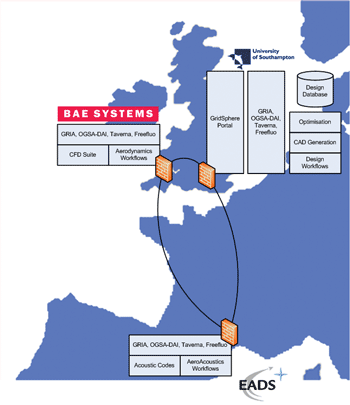 The aerospace industry deals with highly complex products that have data creation, management and curation requirements that span hundreds of collaborating organisations over a 50-year lifecycle. Partners in a product team need to collectively manage thousands of inter-related processes and this leads the industry to expend considerable time and effort in the access, transmission, control, translation and sharing of data. The primary focus of the aerospace activity in SIMDAT is the development and deployment of existing and emerging Grid technologies and concepts to enhance the collaborative engineering of sophisticated products. The improvement in the ability to handle complex problems is not delivered simply through the connectivity that Grid offers, but through the deployment of industry-strength middleware and advanced ontology-based techniques to radically improve the efficiency of the data exchange, both between applications and between organisations
The aerospace industry deals with highly complex products that have data creation, management and curation requirements that span hundreds of collaborating organisations over a 50-year lifecycle. Partners in a product team need to collectively manage thousands of inter-related processes and this leads the industry to expend considerable time and effort in the access, transmission, control, translation and sharing of data. The primary focus of the aerospace activity in SIMDAT is the development and deployment of existing and emerging Grid technologies and concepts to enhance the collaborative engineering of sophisticated products. The improvement in the ability to handle complex problems is not delivered simply through the connectivity that Grid offers, but through the deployment of industry-strength middleware and advanced ontology-based techniques to radically improve the efficiency of the data exchange, both between applications and between organisations
The initial aerospace deployment simulates the multi-disciplinary collaborative configuration design of a low-noise, high-lift landing system. The scenario is typical of sub-system design problems in the context of future-concept, unmanned cargo vehicles that need to use airfields in noise-sensitive locations. The scenario has been designed to show how Grid technologies can support the aggregation of distributed capabilities operating across organisational boundaries.
The deployment of the aerospace prototype demonstrates how Grid technologies can support pan-European inter-Enterprise collaborative development of complex products (Figure 2). Each organisation within the aerospace deployment operates as a GRIA service provider offering specialised engineering services such as optimisation (University of Southampton), parameterised CAD generation (University of Southampton), aerodynamics (BAE SYSTEMS) and aero-acoustics (EADS). GRIA’s explicit business process support for dynamic, bi-lateral QoS agreements allows project managers at aerospace companies to create inter-Enterprise multidisciplinary design teams in a secure, managed, auditable and accountable environment.
GRIA has been significantly enhanced to support the aerospace application scenario through integration with other key Grid technologies. OGSA-DAI WS-I has been integrated with GRIA to provide distributed data access for relational data and simulation files. The GRIA OGSA-DAI service provides security and enforces a business model for managing distributed data resources. A GRIA workflow service has been developed, based on IT Innovation’s open source workflow enactor, Freefluo.12 This allows aerospace engineers to publish workflows as services that can be executed by distributed clients.
The Grid programming environment is provided by the Taverna13 workbench, which has been enhanced to support GRIA’s business process and WS-I Basic Security Profile. Aerospace engineers integrate legacy applications as Grid services using GRIA and compose these applications into workflows using Taverna. The workflows can then be published to GRIA’s workflow enactment service, allowing clients to compose hierarchical distributed workflows that cross organisation boundaries. At the lowest level, the aerospace workflows consist of a simple computational sequence of meshing, solving and post-processing. At higher-levels, the workflows are much more complex. For example, the design workflow (Figure 3) explores the design space by creating a design of experiments (DoE) from a given input specification and iteratively calculating the results for each design point in the DoE. The workflow implementation invokes optimisation, CAD generation and compute workflows, along with staging input and output data in a design database accessed through OGSA-DAI.
Programming Grid-based engineering workflows is a complex problem that can only be currently achieved by expert aerospace engineers. Workflow management and accessibility by less experienced users is a key requirement for aerospace companies. In the first SIMDAT prototype, an aerospace design portal has been developed and deployed using the GridSphere14 portal framework to provide a simple interface to the design workflow. However, future work will focus on workflow management and integration with existing aerospace problem solving environments.






